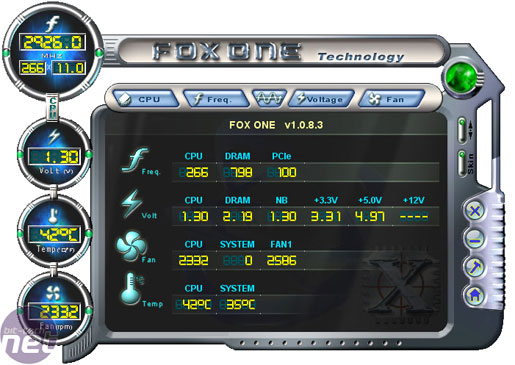Stability
Foxconn has produced an exceptionally stable motherboard. A full 24 hours after we started two instances of Prime 95 (one per core), FarCry looping and IOMeter running on a separate hard drive, everything was still running perfectly.The choice of cooling with heatsinks and fans, over just heatpipes guarantees a certain level of stability from consistently keeping the chipset cool. However, this also means you have to put up with the additional fan noise.
During testing we didn't have a single system lock-up or blue screen either, further adding to the positive user experience.
Overclocking
Overclocking was a thorough disappointment to be honest. Even Foxconn expected more than we achieved and after swapping out the physical BIOS chip to check all possible problems we could not get the board above 365MHz FSB. We even checked to see if it was a "FSB hole" specific to the board but nothing would budge it.After much discussion with Foxconn, the company confirmed that, after testing the retail boards released just this week, the problem isn't just limited to our board. Thus, you can essentially take pot luck as to what you will get.
But to put this in context, it's only overclocking and that's never a given anyway: at least the board is designed to be stable at stock speeds or small overclocks. If you're buying a high end Core 2 with a locked multiplier, your CPU's limit will be close to this board on aircooling.
Warranty
Foxconn provides a healthy three year warranty in the UK, with the board firstly being returned to the point of purchase before subsequently reaching Foxconn UK for an exchange. In comparison this is slightly better than two years from MSI and equivalent to three years from Asus, but a shade short of EVGA's ten year warranty.Conclusion
Despite being quite noisy, the Foxconn N68S7AA is a well laid out and pretty good looking motherboard. It bridges the gap between enthusiast performance and the ability to still use legacy peripherals, with a colour scheme to clearly show you what goes where. There are no serious incompatibilities with the socket placements, and you are provided with a bit of everything when it comes to connectivity.While initial impressions of the FoxOne software for Windows were poor, as you can literally go away and make lunch as it calibrates, once it does load, everything works as it should and the programme is easy to use. We'd still recommend overclocking from the BIOS, but that's a given since it provides a level of system intimacy and knowledge lost when using Windows tools.

Despite all this I can't help but feel a little muted towards the N68S7AA. It's not edgy or racy like an Abit I-series or DFI LANParty boards, and you don't get that slight tingle when using it. It certainly works very well but feels as though it's missing something special. For £158.57 (inc VAT), it undercuts most of the competition like the EVGA nForce 680i SLI but the Inno3d nForce 680i SLI which we reviewed here has now dropped to just £154. Both are probably as noisy as each other, but the Inno3D overclocks far better. Alternatively, you could go for the updated nForce 680i LT SLI chipset such as the new XFX board and save a ton of cash.
Final Thoughts
Since the nForce 680i LT SLI release, you have to have something pretty damn special from a full fat nForce 680i SLI motherboard to justify the cost and Foxconn just doesn't quite have it here. It does have a very stable motherboard which is a somewhat rare commodity these days, but from an enthusiast chipset, Foxconn is only half way there supplying enthusiast performance but not enthusiast overclocking.




MSI MPG Velox 100R Chassis Review
October 14 2021 | 15:04









Want to comment? Please log in.